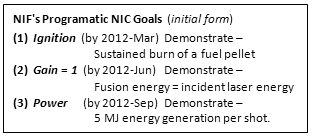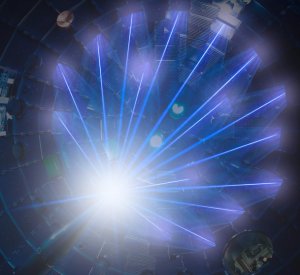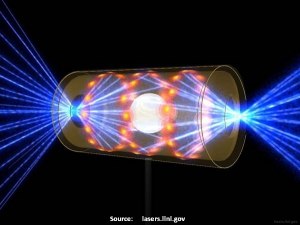Have U.S. laser fusion goals been delayed by the atomic weapons establishment?
In the news this week NIF (National Ignition Facility) at Lawrence Livermore National Laboratory (LLNL) has had its fusion energy test plans slowed an unknown number of months, apparently by nuclear weapons related studies with higher precedence. LLNL is the California-based government laboratory tasked with safeguarding our nuclear weapons inventory, although it has a history of broadening itself into other activities.
The apparent retasking of NIF activities was publicized by an article (Laser Fusion Alters Goals, Fueling Concern Over Strategy) by Daniel Clery in the 2012-Jan09 issue of Science Magazine. (Science is a professional journal for active researchers with the best weekly summaries of scientific news and politics to be found; the content is not free but is always meaningful.)
Fig 1 shows the NIF facility at LLNL. The left image is a aerial picture of the building. The 10 m (30 ft) diameter test chamber is represented by the scaled silver ball added to the image (upper left on building). The chamber is inside and below the ball. The rest of the building houses the lasers and beamlines. The image on the right is the building’s entrance, also visible in the left-hand image.

Fig 1. (L) NIF Bldg. A target chamber sized sphere is sketched, top left. (R) NIF Entrance also seen in (L)
Generation of fusion energy using lasers is the goal of ICF (inertial confinement fusion) research in Japan, Europe, China and on around the world. The initial task for all is to demonstrate nuclear fusion at a break-even level, then to develop optimal strategies that could lead to power generation.
Fig. 2 shows NIF in operation, but probably in a set up mode. When running fusion power, the laser beams would not be visible because the 30 ft chamber would be under vacuum. Note our banner picture. On the right is a target shot in the KMS Fusion chamber dating from the mid 1980s. This NIF shot is the very modern update to target shots going back to the 1970s, when KMS Fusion set the then-record of fusion events in a target implosion.
NIF is the largest laser complex in the world, with the best capability to demonstrate fusion energy generation using intense beams of light. The officially publicized goal is to use the giant array of high power lasers to collapse a capsule of deuterium (D) and tritium (T) fuel to ultrahigh density and temperature and ignite a fusion burn that would consume most of its fuel.
 NIF’s fusion goals, called the National Ignition Campaign (NIC), has had 3 milestone achievements that it must meet. The goals have been set since NIF was selected for fusion power demonstration in 1990. The completion dates have evolved since dedication in 2009.
NIF’s fusion goals, called the National Ignition Campaign (NIC), has had 3 milestone achievements that it must meet. The goals have been set since NIF was selected for fusion power demonstration in 1990. The completion dates have evolved since dedication in 2009.
The problem – none of these are going to happen on this schedule. Before Christmas last year, NIF director Edward Moses signed a new timing sequence that officially delayed timing of (1) and (2) by 3 months and deleted (3) entirely.
Every one seems to be blaming the National Nuclear Security Administration for insisting that it get time on the machine for atomic weapons studies. Isn’t it terrible that the worthwhile fusion-for-the-people is subordinated to military demands? Ans: NO. It takes a bit to explain why, though.
NIF is fundamentally a nuclear weapon modeling facility
Bear with me or skip to HERE to bypass a bit of history.
At the end of the 1980’s a competition was held for who in the US would build the next bigger ICF laser (ICF stands for inertial confinement fusion). The main proposers were:
- Los Alamos National Laboratory proposed a huge KrF laser (krypton fluoride emits in the high energy UV region of light). This was an upgrade to their Aurora ICF program that was just starting to come on line and generate interesting results.
- Sandia National Laboratory (Albuquerque New Mexico) proposed a huge lithium beam site, similar to their PBFA lab, then just starting up.
- LLNL proposed replacing its older NOVA laser facility with a much bigger laser. The new laser would generate beams at the traditional infra-red (IR) wavelenghts.
- The Laboratory for Laser Energetics at the University of Rochester (NY) proposed a huge IR laser to replace its Omega facility.
 LLE presented the only proposal for direct-drive fusion, where the laser beam, itself, would strike the spherical target.
LLE presented the only proposal for direct-drive fusion, where the laser beam, itself, would strike the spherical target.
The others proposed indirect-drive using hohlraum technologies.
None of the proposals were cheap; the enterprise was too big for the inertial fusion energy part of the Department Of Energy. Since underground bomb testing was no longer legal, pressure was put on the weapons community to put up the funding. But lasers are not very useful as bomb simulators; the community balked at spending the money. Under strong political suasion, they reluctantly agreed to bankroll NIF with the proviso that it be used for their needs.
 NIF is best thought of, not as a laser fusion test facility, but as an extension of the atomic bomb evaluation efforts of our country.
NIF is best thought of, not as a laser fusion test facility, but as an extension of the atomic bomb evaluation efforts of our country.
So, no, NIF is not being retasked to weapons work, the fusion efforts are the retasking jobs, no matter what the press says.
The fusion job is not just “dump energy here, scoop up more there.”
If NIF does meet even these new relaxed NIC requirements, many outside observers (including me) will be very happily surprised if not shocked. The task is daunting.
 The proposed laser was to fire intense pulses; engineering proved intense and budget realities forced a 50% reduction. Surprise! LLNL’s magical theory department showed that the smaller laser would produce almost all the same objectives. They would have performed the same miracle if budgets had forced reduction by a factor of 10.
The proposed laser was to fire intense pulses; engineering proved intense and budget realities forced a 50% reduction. Surprise! LLNL’s magical theory department showed that the smaller laser would produce almost all the same objectives. They would have performed the same miracle if budgets had forced reduction by a factor of 10.
There are physics issues with compressing the pellet and achieving uniform fusion density and pressure. If the target implodes to anything but a smoothly uniform kernal, its yield will much less than expected. We get a dud if the laser energy onto the hohlraum is not enough to compress to ignition. If these things happen for many different reasons, they would keep ICF technology from reliably generating power.
Summary The National Ignition Facility is at LLNL (who won their bid for the program in 1990 and started operations 19 years later). It is still impossible to predict the completion date for its full 3 fusion power program goals.
personal disclosure: I worked in ICF at KMS’s Chroma Laser facility in the 1980s
……………………………….
Charles J. Armentrout, Ann Arbor
2012 Jan 13
Update: 2012 Jan 14: Added comments on figure 2
Have a comment? Click on the title of this post, go to bottom, let us know.
Listed under Technology … Technology > ICF/IFE
Related posts: Click the INDEX button under the Banner picture


